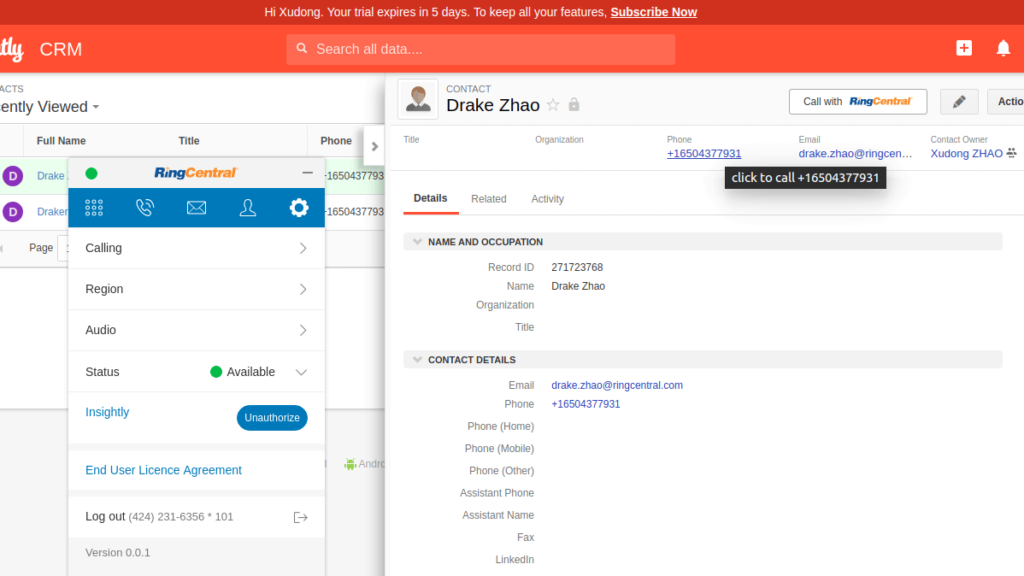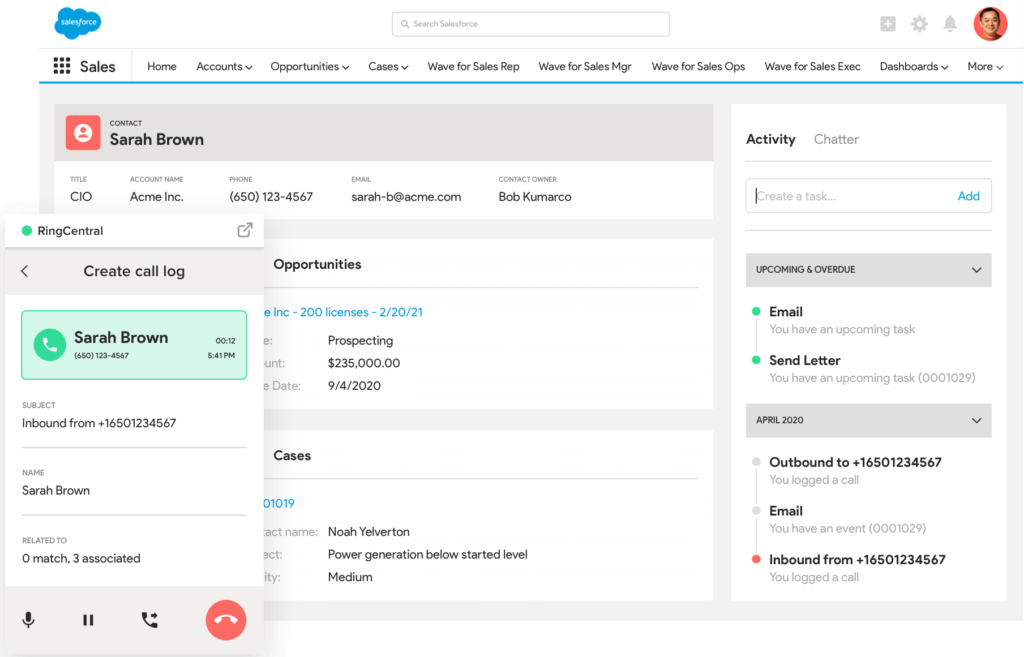Spoiler alert: sales isn’t just something you can “freestyle.”
You need structure. You need some sort of process.
The problem? Sales teams today are drowning in daily tasks and to-do lists. From follow-ups and demos to cold outreach and beyond, it can be difficult to keep all your prospect and customer relationships in order.
Perhaps the best way to rein it all in? Start breaking up your sales process and customer communication into smaller, more manageable stages.
That’s where your sales funnel comes in.
Rather than treat your prospects as one-size-fits-all, a sales funnel streamlines the process of taking a lead from a total stranger to someone who’s sales-ready.
In this guide, we’ll show you how to put together your own funnel to start closing deals faster:
- What is a sales funnel and how does it work?
- Why does defining your sales funnel matter so much?
- What do you need to build a sales funnel?
- How to build a sales funnel from scratch
- What are some ways to optimize your sales funnel?
Up your sales game and close more deals with these free cold outreach scripts. ☎️
What is a sales funnel and how does it work?
To kick things off, let’s start with a quick definition.
A sales funnel represents the stages of your customer journey from beginning to end. Each stage is a progression from the moment someone learns about your product until they’re eventually ready to make a purchase.
For this guide, we’ve broken the sales funnel in five stages:
- Awareness: the stage where someone is introduced to your product, learning about it for the first time
- Interest: the stage where someone shows some sort of interest in your product, desiring to learn more
- Consideration: the stage where someone begins to evaluate your product, deciding whether or not they might eventually make a purchase
- Action: the stage where someone begins to take the steps toward making a purchasing decision (reaching out, setting up a meeting, etc)
- Purchase: the stage where someone actually makes a purchase, setting themselves up to be a long-term customer and advocate for your business
The concept of the funnel is simple: each stage of progression requires a different set of marketing and sales activities to keep people moving.
For example, you wouldn’t pitch someone hearing about your product for the first time the same way you’d pitch someone who’s a customer of one of your competitors.
Learn more about the best sales apps that’ll help you close more deals faster.
Why does defining your sales funnel matter so much?
Chances are you already have some sort of funnel set up already.
For example, do you run ads? Conduct email outreach? Run product demos?
Each of these activities is part of your existing funnel. That said, many businesses don’t consciously think about individual stages or creating a structured process that moves people from Point A to Point B.
Now, let’s look at the funnel itself.
What is the top of the sales funnel? Well, think of a literal funnel. The widest part (the top), which represents the majority of your leads out there, are most likely people who have only a passing knowledge of your product or service.
The problem is that some businesses may focus solely on the top of the funnel, which means they end up missing out on bottom-of-the-funnel leads. Why is that significant? Because these are folks are the ones who are already at the stage where they’re interested in your product or service—they just need a bit of an extra push to actually make a purchase!
Maybe that means running a demo call or encouraging them to sign up for a webinar. Either way, sales (and marketing) teams can’t treat their leads like they have the same level of product knowledge.
Beyond that, let’s look at some key benefits of having a solid sales funnel.
It’s easier to align your sales and marketing goals
In many companies, sales teams struggle because of a lack of alignment with Marketing. The converse is also often true.
On the flip side, research shows that teams with aligned marketing and sales goals experience greater customer retention, higher win rates, and more revenue.1
A sales funnel helps you make sure that your company’s marketing materials address the right prospects at each part of your funnel. For example, you might create general “how-to” blog posts for folks at the top of the funnel and specific webinars highlighting your product in action to someone at the bottom of the funnel.
This also signals the need for internal communication between your sales and marketing team. Salespeople should be willing to share their insights and experiences talking to prospects. Meanwhile, marketers could let Sales know which sorts of campaigns and messaging are their top performers.
It encourages your sales team to be more proactive
Remember what we said earlier about sales teams being overwhelmed?
Recent research notes that a big reason that the average salesperson is struggling to meet their quotas is because of the many time-consuming tasks on their plates.2
This is yet again where the sales funnel concept can help. By looking at your prospects in their respective stages, it’s much easier to figure out “what’s next” with them in terms of sales activities.
For example, it makes much more sense to prioritize a follow-up with someone who requested a demo versus someone who just signed up for your email list or downloaded an eBook. In the case where a salesperson is up to date on all of their follow-ups, they can begin research or conducting cold outreach.
In short, a sales funnel encourages a more proactive approach to sales by sorting prospects into tiers based on how close they are to, well, closing.
It helps you pinpoint weaknesses in your sales cycle
Every company has weaknesses in their sales funnel, even if they don’t know it.
Let’s say your sales team is great at getting people to the demo stage, but just can’t seem to convert deals from there. This could signal a problem with your approach to demos. (Perhaps they’re too long, not in-depth enough, etc.)
By identifying these problems, you can take steps towards “plugging” up these holes—and generate more customers as a result.
What do you need to build a sales funnel?
Good question. A sales funnel isn’t necessarily something you have to “build,” per se.
Instead, consider the actions you need to take in this process—like communicating with your team, moving your prospects through the stages, and tracking your success each step of the way.
Marketing campaigns, tools, and analytics
You can’t have a sales funnel with a constant influx of prospects and leads.
Here’s a snapshot of some of the inbound marketing strategies available to businesses that can start at the top of the funnel:
- Lead magnets (think: free guides, eBooks)
- Email newsletters
- Social media ads
- Google ads
- Website SEO
- Marketing videos
- Blog posts
These tactics and resources are perfect for reeling people in and building interest in your products. For example, someone who exchanges their phone number or email in exchange for a demo, or opens your emails at a super high rate are likely good candidates for sales outreach. From there, you can move them through your funnel.
Which marketing tactics you rely on really depend on your business. In most cases, you need a combination of campaigns working in tandem to attract leads.
A CRM system
With a CRM system, you can actually track and make notes for each customer along each step of their journey.
For example, customer service tools, sales software, and CRMs like Pipedrive allow you to log each of your customer interactions like phone calls, emails, and other meetings. You can also log their activities on your website like email opt-ins or other webform entries.
Based on your prospects’ actions, you can see which stage of the funnel they’re at. Logging interactions is especially important later in your funnel as people begin to ask specific questions related to product pricing (or bring up pesky sales objections):
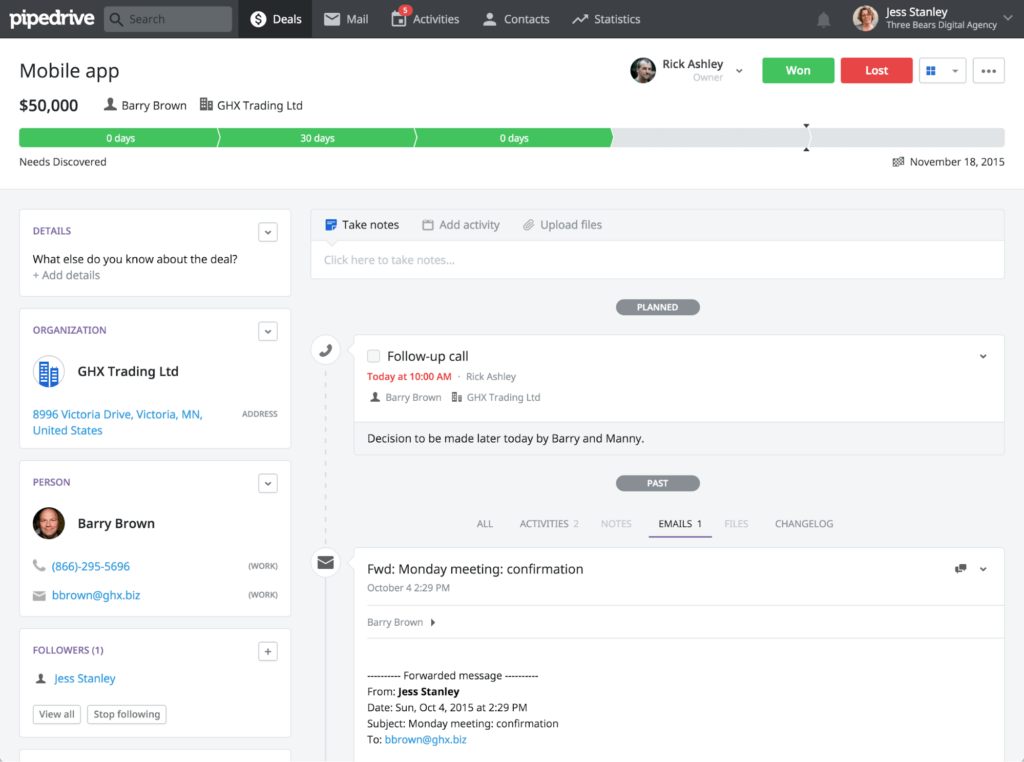
Your CRM is also crucial to ensuring that you follow up with your leads and prospects in a timely manner. Pipedrive actually has a built-in view where you can move each individual deal into a different stage in your funnel. This gives you a birds-eye view of your prospect relationships and who your top priorities are:

A communications platform
Now, this is where it all comes together. When we talk about “moving” people through your funnel, we’re talking about having conversations with them.
Phone calls. Emails. Live chat and video meetings. The list of channels where you can use different sales techniques goes on and on.
Regardless of how you get in touch, you need a communications platform to do the heavy lifting. That’s where a tool such as RingCentral comes in.
Our platform is an all-in-one communications suite that lets you talk to leads and prospects regardless of where they’re reaching out from. Need to conduct a screen-sharing video chat? Want to hop on a group call or do some cold outreach over the phone? With RingCentral, you can do all of that and then some.
Another added bonus of a tool such as RingCentral is that you can prioritize speed while moving folks through your funnel. For example, its integrations with email and CRM platforms mean that you can conduct outreach—without having to switch back and forth between tools. This means that you maintain your much-needed sense of efficiency while keeping all of your customers’ contact information in one place (like Insightly’s CRM):
RingCentral also helps with workplace collaboration as your sales and marketing teams work together to close deals via team messaging and video conferencing. For example, you can quickly ask questions, screen share, and share resources through the desktop and mobile app:
How to build a sales funnel from scratch
Now, let’s look what a “built” sales funnel looks like in action. Below we’ve broken down the various stages of a funnel, and the marketing and sales activities that you should plan around them in order to fill out your sales funnel.
Awareness: Let people know who you are and what you do
The awareness stage represents your first touchpoint with a potential customer.
For example, let’s say a customer comes across your company’s website during a Google search or sees an ad pop up via Instagram:
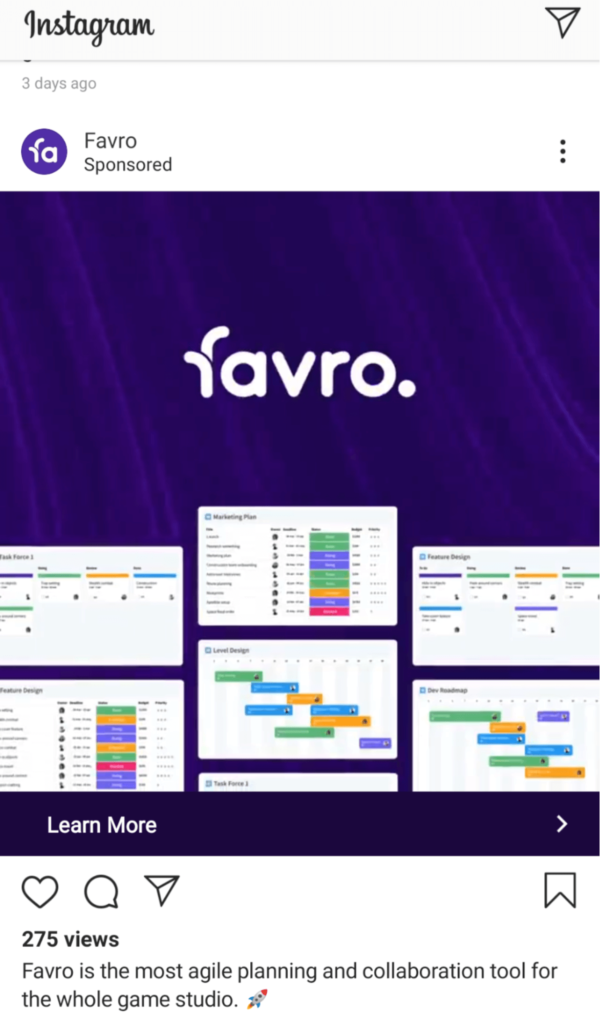
Although this initial encounter might not seem like a game-changer, you’ve at the very least made someone peripherally aware of you.
This first step is important because statistics says that it takes up to eight touchpoints for someone to be considered an actual prospect.3 Now, we’re not saying that activities at the awareness stage aren’t valuable, but rather, you have to be persistent.
For example, let’s say the person who found you via Google then sees a post mentioning you on social media. From there, they check out your profile and maybe even your company blog. Each of these interactions help lead people toward the next stage of your sales funnel.
Interest: Give people the “lightbulb moment” that turns them into a potential customer
During the interest stage, your prospects begin to take actions that signal they could eventually become customers.
These types of actions might include:
- Subscribing to your email list
- Downloading your company’s eBook
- Listening to your company’s thought leadership podcast
People don’t take these actions “just because.” When somebody provides their contact information, it’s essentially an exchange. It’s also a golden opportunity to reach out to prospects who could become legitimate leads.
The faster you’re able to reach out to leads and prospects, the better. This is where an outbound tool like RingCentral can help, enabling you to quickly identify and get in touch with prospects sooner rather than later. Here’s a quick look at how it works:
For example, here’s how Salary.com uses RingCentral:
The company’s sales team is benefiting from RingCentral’s Salesforce integration, which lets reps use a RingCentral pop-up in their Salesforce account to autodial a prospect’s number with a single click. “Our sales team also likes this tool because it lets them add real-time notes to the system during the call, and it automatically logs key details, so they don’t have to manually enter that data afterward.”
Consideration: Help people imagine your product in their hands
Now things are getting serious.
During the consideration stage, leads really begin racking their brain to figure out whether they’re going to make a purchase.
This might be a time where they start researching on their own how your product stacks up against competitors. Resources such as this blog post, for example, are helpful for not only positioning your product as #1, but also educating your leads. Additional resources like produce video demos are useful here, too:
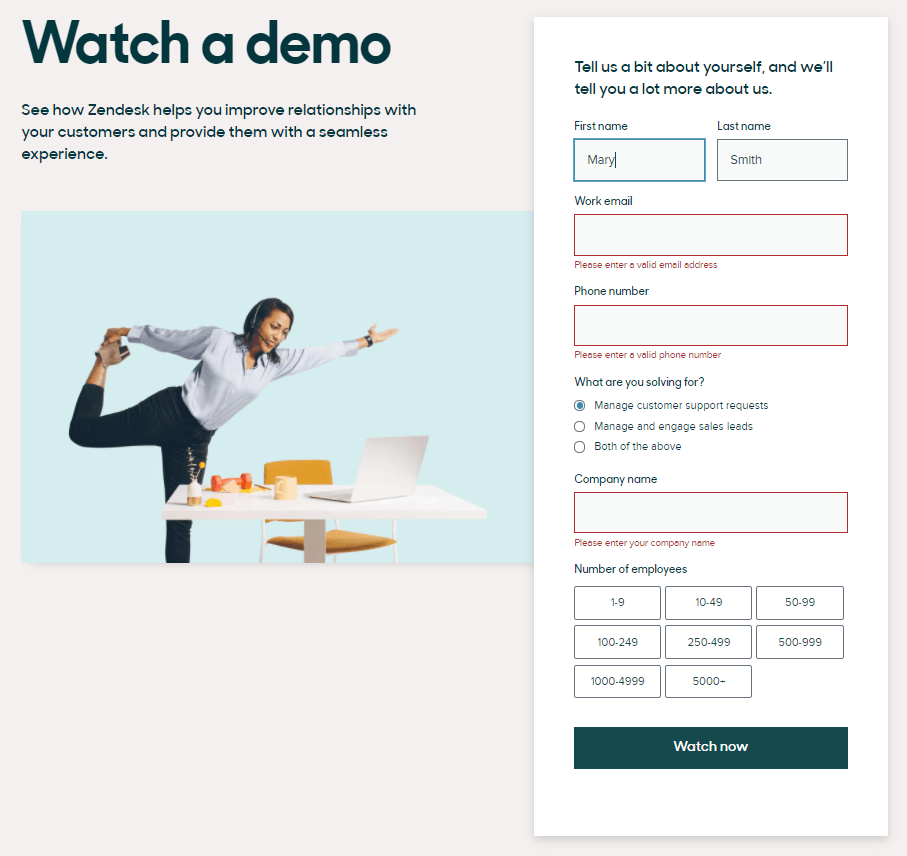
Leads in the consideration stage are also likely to reach out to you for additional information or clarification about your product. This is yet again where your communications suite comes into play. For example, you need to be able to respond to leads regardless of whether they’re reaching out via phone, email, or live chat:
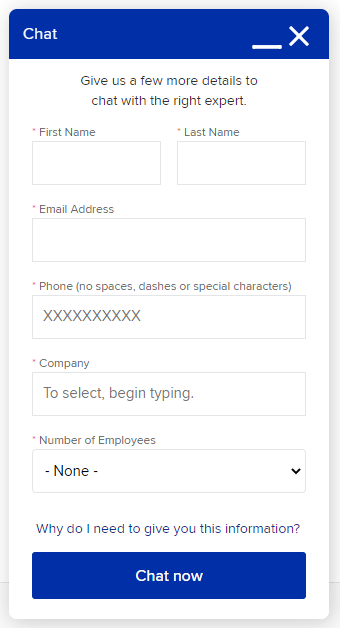
Action: Guide people toward actions that result in a purchase
At the action stage, you’re looking for one final push that’ll guide someone to make the decision to sign on the dotted line.
This includes one-on-one calls and personalized demos. Once people have gotten to this point, they’re clearly committed to making a choice. Anything you can do to make a meaningful impact on your leads during this stage is a plus.
This means sharing presentations, resources, and putting your face to your company’s name via video. Tools like RingCentral’s video conferencing platform give you everything you need to virtually demonstrate how your product works—and ultimately win prospects over. Need to go from a phone call to a video call so you can share your screen with your prospect? You can do that too!
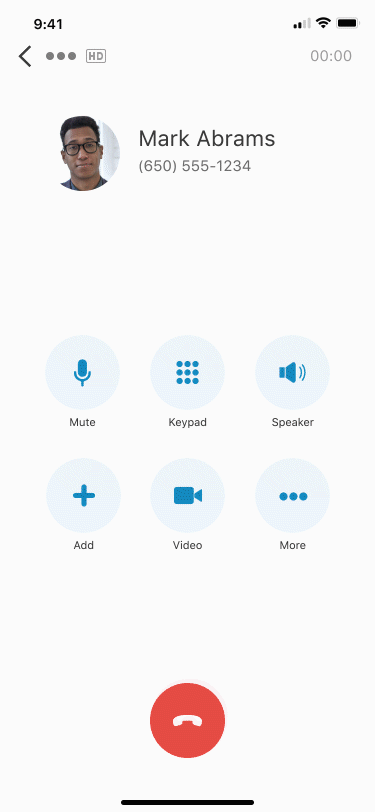
🕹️ Get a hands-on look at how RingCentral works by booking a product tour:
Purchase: Convert customers and turning them into long-term advocates
Lastly, there’s the purchase.
This is the end-stage of your sales funnel, but not necessarily where the customer’s journey ends.
You’ve probably heard that it costs way more to acquire a new customer than it does to retain the ones you already have. Check-ins, product recommendations, and review requests are all great ways to ensure that your customers are indeed satisfied and stick around long term:
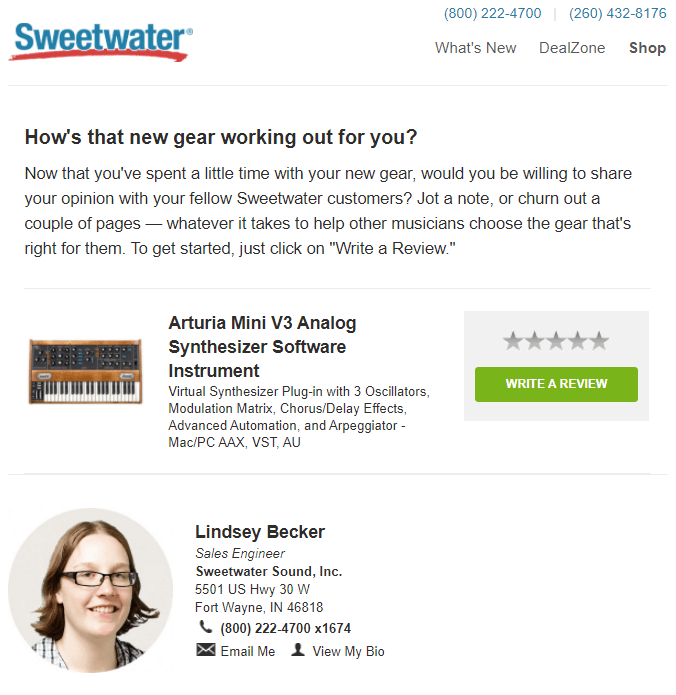
What are some ways to optimize your sales funnel?
To wrap things up, we’ll briefly discuss some ideas to improve your sales funnel strategy and close more deals.
Explore new ways to generate leads
No surprises here. The sales process begins at the top of the funnel, meaning that you should always consider new ways to bring people into it.
Doing so starts by expanding the channels that are already working. For example, let’s say you get the majority of your leads from an eBook or white paper. As a result, it might make sense to focus on creating similar education resources or a different type of resource (think: a webinar or video) that covers the same topic.
Pay close attention to your performance and metrics
Fine-tuning your funnel to avoid leaks means paying close attention to your data.
If you have a CRM and log your interactions with leads, figuring out where your leaks are is pretty straightforward.
For example, Pipedrive has built-in dashboards that highlight which stage leads were won and lost in your funnel. They also have a “reasons lost” data point you can track to put those lost leads into context (think: too expensive, decided to go with a competitor, etc):
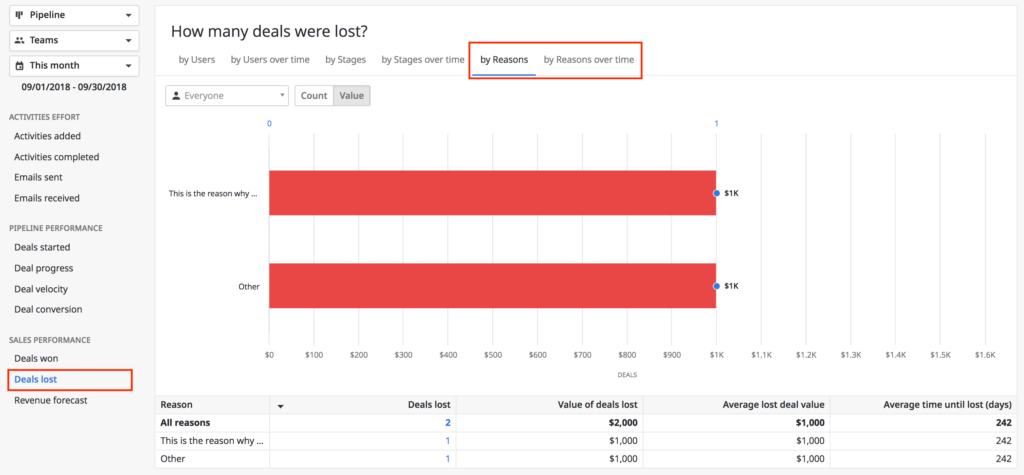
Beyond obvious leaks, another way to optimize your funnel is by speeding up your sales process. If it takes a month on average to close a deal, start exploring ways to increase your speed to lead. This again brings up the importance of a communications platform like RingCentral, which puts you in touch with your prospects with no lag time.
Regularly communicate your findings across departments
Again, the activities that drive people through your funnel don’t happen in a vacuum. From where leads are lost to top-performing marketing contact, regular discussions among your marketing and sales team should be a staple of your funnel strategy.
And not to sound like a broken record, but RingCentral can help there, too. With a communications suite that includes collaboration and file-sharing features, you can quickly work together with anyone and everyone in your organization at a moment’s notice.
What does your business’s sales funnel look like?
If you want a more streamlined approach to sales, structuring your sales funnel should be a top priority.
Simply understanding the differences between funnel stages and how to appeal to prospects at each level ensures that your sales process makes sense.
Either way, consider how RingCentral speeds up your business’s communication whether you’re selling to customers or talking to your own team.
1blog.zoominfo.com/sales-and-marketing-alignment-statistics
2pipedrive.com/en/blog/state-of-sales
3blog.hubspot.com/sales/the-ultimate-guide-to-prospecting-how-many-touchpoints-when-and-what-type
Originally published Oct 14, 2020, updated Dec 30, 2022


